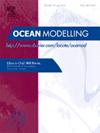RLM: Rearranged level-set method - An efficient approach for calculating temporally continuous Lagrangian Residual Velocities
IF 2.9
3区 地球科学
Q2 METEOROLOGY & ATMOSPHERIC SCIENCES
引用次数: 0
Abstract
The Lagrangian Residual Velocity (LRV) is the subtidal residual current extracted from oscillating tidal water motions to depict the coastal circulation. Since the LRVs are sensitive to the initial time, the most widely used particle tracking method (PTM) must be used repeatedly to obtain temporally continuous LRVs. A new method, the rearranged level-set method (RLM), is introduced to efficiently obtain temporally continuous LRVs. Compared with the analytical solution of LRVs in a long narrow bay, both the RLM-LRVs and the PTM-LRVs can reproduce multiple gyre structures. However, the region of directional bias above 60° in the RLM-LRVs is limited to the narrow gyre conjunction region, while that in the PTM-LRVs extends up to half the bay width and 10% of the bay length. In particular, the RLM can produce temporally continuous LRVs with much higher computational efficiency than the PTM. The RLM also performs well in complex coastal sea areas, such as a cape with a staircase topography, rectangular coastline, and Jiaozhou Bay (JZB), a realistic small waterbody with complex coastline and topography. The RLM-derived temporally continuous LRVs can illustrate the evolution of the two small gyres perturbed by the staircase topography in the cape, and the two gyre cores embedded in the large dominant counterclockwise gyre move separately along the deep channels in the JZB while the PTM cannot. In conclusion, the RLM is a fast and accurate method for calculating temporally continuous LRVs.
重新排列水平集方法——计算时间连续拉格朗日残差速度的有效方法
拉格朗日剩余速度(LRV)是从振荡潮汐运动中提取的用于描述海岸环流的潮下剩余流。由于lrv对初始时间非常敏感,为了获得时间连续的lrv,必须重复使用最常用的粒子跟踪方法(PTM)。提出了一种有效获取时间连续lrv的新方法——重排水平集法(RLM)。与lrv在长窄湾的解析解相比,rlm - lrv和ptm - lrv都能再现多个环流结构。然而,在rlm - lrv中,60°以上的方向偏置区域仅限于狭窄的环流连接区域,而在ptm - lrv中,方向偏置扩展到海湾宽度的一半和海湾长度的10%。特别是,RLM可以产生时间连续的lrv,计算效率比PTM高得多。RLM在复杂的沿海海域也有良好的表现,例如具有阶梯地形的海角,矩形海岸线,以及具有复杂海岸线和地形的真实小水体胶州湾(JZB)。rlm导出的时间连续lrv可以说明两个受阶梯形地形扰动的小环流的演化过程,并且嵌入在大型逆时针环流中的两个环流核分别沿着JZB的深通道运动,而PTM则不能。综上所述,RLM是计算时间连续lrv的一种快速、准确的方法。
本文章由计算机程序翻译,如有差异,请以英文原文为准。
求助全文
约1分钟内获得全文
求助全文
来源期刊

Ocean Modelling
地学-海洋学
CiteScore
5.50
自引率
9.40%
发文量
86
审稿时长
19.6 weeks
期刊介绍:
The main objective of Ocean Modelling is to provide rapid communication between those interested in ocean modelling, whether through direct observation, or through analytical, numerical or laboratory models, and including interactions between physical and biogeochemical or biological phenomena. Because of the intimate links between ocean and atmosphere, involvement of scientists interested in influences of either medium on the other is welcome. The journal has a wide scope and includes ocean-atmosphere interaction in various forms as well as pure ocean results. In addition to primary peer-reviewed papers, the journal provides review papers, preliminary communications, and discussions.
 求助内容:
求助内容: 应助结果提醒方式:
应助结果提醒方式:


